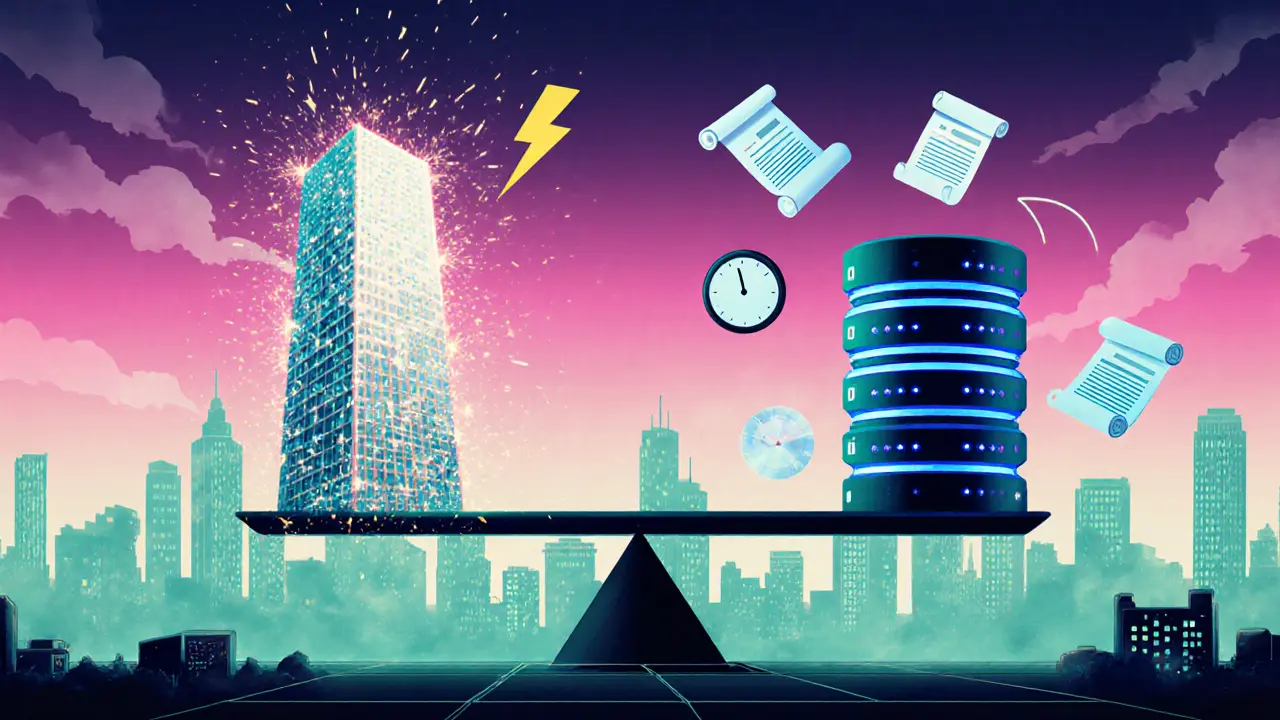Blockchain Benefits and Limitations: How Distributed Ledgers Transform Business
 May, 15 2025
May, 15 2025
Key Takeaways
- Blockchain offers immutable records, reducing reconciliation costs by billions annually.
- Public networks struggle with scalability-Bitcoin handles ~7 TPS, Visa processes ~24,000 TPS.
- Permissioned solutions like Hyperledger Fabric can reach 3,500‑10,000 TPS but trade off decentralization.
- Real‑world wins appear in supply‑chain traceability and cross‑border payments.
- Complexity, energy use, and regulatory uncertainty remain major hurdles.
When you hear the term Blockchain technology is a distributed ledger that records transactions across a network of computers without a central authority, the first thing that comes to mind is usually cryptocurrency. Yet the real story goes far beyond Bitcoin or Ether. Today, businesses worldwide are tapping into the core blockchain benefits-security, transparency, and trust-while grappling with practical limitations that can make or break a project.
What is a Distributed Ledger?
A distributed ledger is simply a database that lives on many nodes simultaneously. Each node stores a copy of the data, and any change must be approved by a consensus mechanism-a set of rules that guarantees everyone agrees on the same state. In public blockchains, this often means proof‑of‑work (PoW) or proof‑of‑stake (PoS). In permissioned networks, the consensus can be a voting protocol among known participants, which speeds up processing.
Core Benefits of Blockchain
Here are the five pillars that make blockchain attractive to enterprises:
- Immutability - Once a block is added, cryptographic hashing (e.g., SHA-256 in Bitcoin) makes retroactive changes practically impossible.
- Transparency - Every participant can view the same ledger, eliminating hidden data silos.
- Reduced Intermediaries - Smart contracts (smart contracts on Ethereum) automate enforcement, cutting out middlemen and saving fees.
- Security - Distributed consensus and cryptographic signatures protect against tampering and single‑point failures.
- Auditability - An immutable trail simplifies compliance and forensic analysis.

Real‑World Examples of Benefits
These advantages aren’t just theory. Companies across sectors have reported tangible gains:
- Finance: IBM estimates blockchain can save $8‑12 billion a year for banks by removing manual reconciliation.
- Supply Chain: The MediLedger network cut counterfeit pharmaceuticals by 37 % by letting every stakeholder verify product provenance.
- Cross‑Border Payments: Ripple’s xCurrent reduced settlement time from days to under four seconds for Santander.
- Humanitarian Aid: UNICEF’s Kenya pilot processed $1.2 million in stablecoin aid with 98 % recipient satisfaction.
Primary Limitations to Consider
Every technology has trade‑offs. Blockchain’s most cited drawbacks include:
| Aspect | Benefit | Limitation |
|---|---|---|
| Throughput | Immutable record keeping | Public chains: 7‑30 TPS vs. Visa’s 24,000 TPS |
| Energy Use | Security via PoW | High electricity consumption (Bitcoin ≈ 120 TWh/yr) |
| Latency | Instant smart‑contract execution | Typical block times 10‑15 seconds; not suitable for sub‑millisecond trading |
| Complexity | Programmable business logic | Steep learning curve; 6‑12 months deployment |
| Regulation | Transparent audit trails | Unclear legal status; compliance varies by jurisdiction |
Scalability is the headline worry. Bitcoin’s 7 TPS and Ethereum’s ~30 TPS cannot support mass‑market applications without layer‑2 or sharding solutions.
Technical Constraints Explained
Beyond raw speed, other technical factors hinder adoption:
- Storage growth: Full Ethereum nodes add roughly 1 GB of data per month, demanding robust infrastructure.
- Security attacks: A 51% attack could let a single entity rewrite history, a risk highlighted by over 58 confirmed attacks since 2016.
- Key management: Loss of private keys locks users out forever; Deloitte reports 22 % of wallet users lose access.
- Interoperability: Different chains speak different languages, making data exchange costly and risky.

Emerging Solutions and Mitigations
Developers aren’t standing still. Several approaches aim to fix the biggest pain points:
- Layer‑2 scaling - Rollups (e.g., Polygon’s zkEVM) achieve 2,000 TPS while preserving security.
- Sharding - Ethereum’s “Dencun” upgrade partitions the network, boosting throughput.
- Permissioned blockchains - Hyperledger Fabric and R3 Corda trade full decentralization for 3,500‑10,000 TPS.
- Post‑quantum cryptography - NIST’s upcoming standards aim to guard against future quantum attacks.
- Standardized bridges - Cross‑chain protocols improve interoperability while tightening security after incidents like the 2022 Wormhole hack.
Decision Checklist: When to Use Blockchain
Not every use‑case needs a blockchain. Ask yourself these questions:
- Do I need an immutable audit trail that multiple parties must trust?
- Is there a high cost from intermediaries that can be eliminated?
- Can the solution tolerate latency of 10‑15 seconds per block?
- Do I have the technical talent (cryptography, smart‑contract dev) to build and maintain the network?
- Are regulatory requirements clear for my industry and jurisdiction?
If you answer “yes” to most, blockchain is worth exploring. If you need sub‑millisecond speeds or have tight budgets, a traditional database may still be the better bet.
Frequently Asked Questions
What makes blockchain more secure than a traditional database?
Security comes from decentralization and cryptographic hashing. Every node validates transactions, so an attacker must control >50 % of the network’s computing power to alter data-a feat that’s practically impossible for large public chains.
Why is scalability such a big issue for blockchains?
Each block must be verified by many nodes, which limits how many transactions can be packed into a single block. Bitcoin’s 10‑minute block time and Ethereum’s 12‑second time lead to low TPS compared with centralized systems that can process thousands of transactions instantly.
Can I use blockchain for high‑frequency trading?
Not today. The latency of public blockchains (seconds per block) is far slower than the sub‑millisecond speeds required for HFT. Private, permissioned ledgers improve speed but still lag behind specialized trading platforms.
How do permissioned blockchains differ from public ones?
Permissioned chains restrict who can join the network and often use faster consensus algorithms (e.g., Raft, PBFT). This boosts throughput (up to 10,000 TPS) but reduces the trust‑less property that public chains provide.
What are the biggest regulatory challenges?
Rules vary by region. The EU’s MiCA offers a unified framework, while the U.S. still relies on state‑by‑state guidance. Companies must navigate AML/KYC obligations, data‑privacy laws, and tax reporting for tokenized assets.
Trent Mercer
October 24, 2025 AT 13:40And don't get me started on 'decentralization.' You think a consortium of five banks using Hyperledger is decentralized? Please. It's a private club with a blockchain-shaped sticker on it.
Kyle Waitkunas
October 25, 2025 AT 07:50Remember when they said 5G was for faster streaming? Look where we are now. This is the same playbook. Wake up.
vonley smith
October 25, 2025 AT 14:27It’s not magic. But when it’s the right tool? It’s a game-changer. Don’t write it off because it’s new. Try it on a tiny scale first. You might be surprised.
Melodye Drake
October 26, 2025 AT 13:22And don’t even get me started on ‘smart contracts.’ You think a contract written in Solidity is more trustworthy than one signed by a lawyer? Honey. I’ve seen smart contracts that locked people out of their own funds because someone forgot a semicolon.
It’s not innovation. It’s a tax on gullibility.
paul boland
October 26, 2025 AT 16:53And don’t even mention ‘decentralization’ - your whole system runs on AWS. Face it. You’re just outsourcing control to Silicon Valley. We’re doing real innovation here. 🇮🇪☕️
harrison houghton
October 27, 2025 AT 07:02When a transaction is recorded, it is not merely data - it is a permanent act of will. A digital soul. A fingerprint of intention. And when we erase the possibility of revision, we erase the possibility of redemption.
Is that what we want? A world where every mistake is etched in stone? Where forgiveness is a technical impossibility?
Blockchain doesn’t solve trust - it institutionalizes paranoia.
DINESH YADAV
October 28, 2025 AT 04:06You call it ‘scalability issue.’ We call it ‘your privilege.’ We don’t need your permissioned chains. We’re building our own.
rachel terry
October 28, 2025 AT 08:37Also why is everyone so obsessed with ‘decentralization’? I just want my payments to work. I don’t need a blockchain to prove I bought coffee
Susan Bari
October 28, 2025 AT 19:17Sean Hawkins
October 29, 2025 AT 17:53The real failure isn’t the tech - it’s the overhyping. Enterprises are trying to force it into CRM systems and HR portals. That’s like using a chainsaw to cut butter.
Stick to traceability, settlement, and identity. Everything else is noise.
Marlie Ledesma
October 30, 2025 AT 13:37It’s not about the hype. It’s about the quiet wins.
Daisy Family
October 30, 2025 AT 20:11Paul Kotze
October 31, 2025 AT 02:53It’s not about the ledger. It’s about accountability. That’s the real innovation.
Jason Roland
October 31, 2025 AT 04:07Do we want systems that are fast and centralized? Or slower, but transparent, resistant to corruption, and owned by the many?
Scalability can be solved. Trust can’t. And that’s why this matters.
Niki Burandt
October 31, 2025 AT 15:57And then the audit team finds 200 unpatched smart contracts and a server running on a 2015 MacBook.
It’s not a revolution. It’s a tech debt time bomb. 🤷♀️
Chris Pratt
November 1, 2025 AT 14:49That’s not hype. That’s human impact. We shouldn’t dismiss it just because it’s not perfect.
Karen Donahue
November 2, 2025 AT 01:22And then they wonder why their investors are mad.
It’s not the tech. It’s the people. The greed. The desperation to be ‘innovative.’
Just use a damn spreadsheet. Or a cloud database. Or a ledger. Anything. Stop pretending you’re building the next internet.
Bert Martin
November 2, 2025 AT 05:44It’s not about being for or against blockchain. It’s about asking: does this solve a real problem better than what we already have? If yes - try it. If no - walk away. Simple.
Ray Dalton
November 2, 2025 AT 19:55But if you’re just storing user profiles or product inventory? Use Postgres. Save the blockchain for when you’re tracking vaccine shipments across war zones or verifying land titles in corrupt countries.
Don’t over-engineer. The best tech is the one you don’t need to explain.
Trent Mercer
November 3, 2025 AT 01:16And don’t even get me started on ‘smart contracts’ - I’ve seen one that froze $20M because a dev used ‘==’ instead of ‘===’. You call that trustless? It’s just a new kind of vendor lock-in.